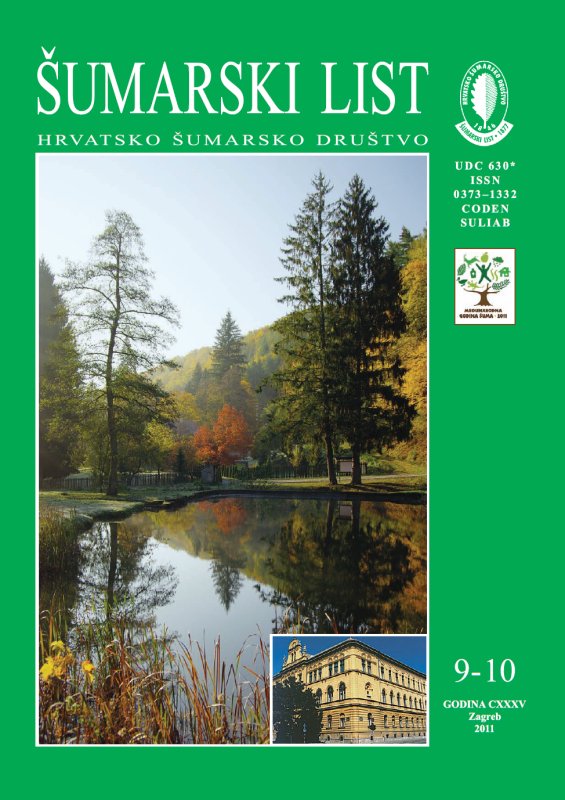
broj: 9-10/2011
pdf (7,5 MB) |
|
||||||||||||||
| RIJEČ UREDNIŠTVA | ||
| Uredništvo | ||
| STATE AWARD FOR SCIENCE FOR THE YEAR 2010 - Lifetime Achievement Award is conferred to Emeritus Professor BRANIMIR PRPIĆ, PhD pdf HR EN | 421 | |
| IZVORNI ZNANSTVENI ČLANCI | ||
| Čavlović,J., K. Teslak, A. Seletković | UDK 630* 622 + 653: 231 (Quercus roburL.)(001) | |
| Application and Comparison of Different Models for Regeneration Planning of Pedunculate Oak Stands (Quercus roburL.) – a Management Unit “Josip Kozarac” Case Study pdf HR EN | 423 | |
| Račko,V., M. Saniga, I. Čunderlík | UDK 630* 811 + 48: 249 (001) | |
| The Impact of Silvicultural Treatments on the Structure and Red Heart Formation in Beech Forests pdf HR EN | 437 | |
| Stevanov,M., M. Böcher, M. Krott, S. Orlović, D. Vuletić, S. Krajter | UDK 630* 945.4 + 935 (001) | |
| Analytic Model of Departamental Research as Science-Based Advising of Actors in Political Process - Analysis of Research Activity of the Institute of Lowland Forestry and Environment from Novi Sad pdf HR EN | 449 | |
| Summary: Many governments express a growing need for having a science that is “usable”, which means that research results should be useful for practical application. In Serbia and Croatia current strategies and laws addressing science and research see public research institutes as organizations with activities primarily oriented toward public interest, in a way that policy actors are provided with timely and adequate science-based information. In this paper we analysed scientific and research activities of public research Institute of Lowland Forestry and Environment (ILFE) to see whether, how and to what extent this institution meets the needs of actors in policy processes, i.e. if it is in line with the requirements of “usable science”. The Model of departmental research (Böcher i Krott 2010), based on sociology of scientific knowledge and analytical theory, has been applied on total scientific and research activities of ILFE. The very Model consists of following spheres: research, integration, scientific and practical utilisation, whereas production lines connect them and stay for activities of research projects (Figure 1). In total 51 research projects of ILFE for the period 2005–2010 have been analysed (table 1), based on project documentation, as well as semi-structured questionnaires and interviews with project leaders and management of the Institutes. Collected information was used in analysis of each project and graphically presented by production line on the model of departmental research. This was followed by synthesis and interpretation of the results. Results showed five types of production lines: (1) Preliminary research, starting in integration sphere, with the idea what will in the future be relevant for particular actor(s). However most activities remain in the research sphere, and foster results toward scientific utilization (Figure 2). In total 15 research projects of ILFE correspond with this type of production line. (2) Research stopped in the integration discourse. This production line also starts in the integration sphere, continues to the research sphere, where project proposal has been made, but its implementation gets stopped by the actors in political process, i.e. in the integration sphere (Figure 3). Only three projects of ILFE correspond with this type of production line. (3) Research oriented toward practical utilisation, where constant interaction between research and integration spheres, ends up in practical utilisation of results (Figure 4). Analysis showed 6 out of 51 projects fall into this group of typical science-based advising of actors in policy processes. (4) Research projects oriented toward scientific and practical utilisation, with the main difference that results are meant not only for practice, but for the scientific community as well (Figure 5). A group of 18 projects can be presented by this production line. (5) Consulting activities of public institutes. In ILFE seven out of 51 projects can be depicted by this type of production line, for which is typical that usually entire project is within the integration sphere with outputs in the practical utilisation discourse. During the research we were able to present all projects of the ILFE by production lines on the model of departmental research. There is a strong connection between ILFE and users of its expertise, with more than half of research projects having practical application (table 1). There are also im portant consulting activities going on which confirms importance of their role and quality of connection with the practise and society. The model proves to be advantageous over existing evaluation methods, while it makes transparent all aspects of departmental research, which is useful for both users of science-based expertise and founders of these institutions. It also makes a solid base for optimisation and quality management processes within institutions. Key words: departmental research; forestry; model of departmental research; production lines; public forest institutes; public institutes; research activities; usable science | ||
| Kirin,T., J. Kralj, D. Ćiković, Z. Dolenec | UDK 630* 152 + 907 (001) | |
| Habitat Selection and Similarity of the Forest Songbird Communities in Medvednica and Žumberak – Samoborsko gorje Nature Parks pdf HR EN | 467 | |
| Uhlíková,H., O. Nakládal, P. Jakubcová, M.Turčáni | UDK 630* 453 (Lymantria monacha) (001) | |
| Outbreaks of the Nun Moth (Lymantria monacha) and Historical risk Regions in the Czech Republic pdf HR EN | 477 | |
| STRUČNI ČLANCI | ||
| Hodić,I., Z. Jurušić | UDK 630* 630 383 | |
| Analysis of Primary Opennes of Forest Managed by Hrvatske Šume Ltd. as Basis for Disigning of Future Policy Forest Roads Construction pdf HR EN | 487 | |


